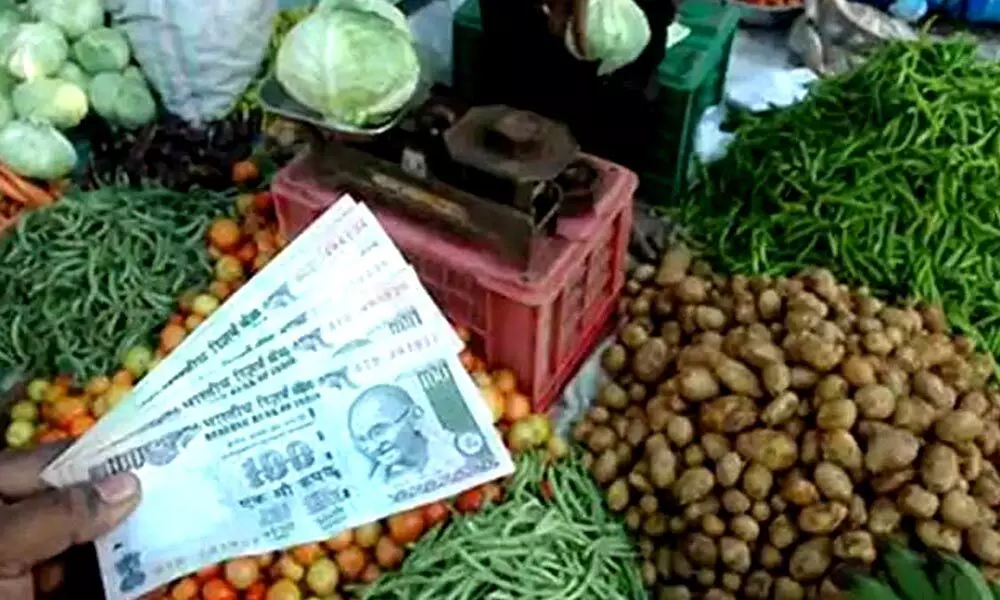RBI pegs inflation at 4.4-5.2%
There are 'some underlying constituents' testing upper tolerance level in FY22, says Governor
image for illustrative purpose

Mumbai: The Reserve Bank of India on Wednesday projected that retail inflation will be well within control at 4.4-5.2 per cent in the current fiscal and that bumper food grains production will soften cereal prices even though there are "some underlying constituents" testing the upper tolerance level. Unveiling its first monetary policy review of 2021-22, the Reserve Bank of India (RBI) left the repo rate unchanged at 4 per cent.
The central bank has the mandate to maintain inflation at 4 per cent, with an upper and lower tolerance band of 2 per cent for the next five years. RBI Governor Shaktikanta Das said that even as the headline inflation at 5 per cent in February 2021 remains within the tolerance band, some underlying constituents are testing the upper tolerance level.
The apex bank has projected the Consumer Price Index (CPI) based retail inflation at 5.2 per cent for the first and second quarters of this fiscal and then decline to 4.4 per cent in the third quarter. For the fourth quarter - January-March 2022 period - the apex bank has estimated retail inflation to be 5.1 per cent.
Going forward, the food inflation trajectory will critically depend on the temporal and spatial progress of the south-west monsoon in its 2021 season, Das said. Further, he noted that some respite from the incidence of domestic taxes on petroleum products through coordinated action by the Centre and states could provide relief on top of the recent easing of international crude prices. Also, Das said that a combination of high international commodity prices and logistics costs may push up input price pressures across manufacturing and services.
"Taking into consideration all these factors, the projection for CPI inflation has been revised to 5 per cent in Q4:2020-21; 5.2 per cent in Q1:2021-22; 5.2 per cent in Q2; 4.4 per cent in Q3; and 5.1 per cent in Q4, with risks broadly balanced," he said. Earlier, the central bank projected retail inflation at 5.2 per cent for the 2021 March quarter, which now has been revised down to 5 per cent. Hoping that cereal prices should soften because of bumper foodgrains production in 2020-21, he said mitigation of price pressures on key food items such as protein-based components and edible oils would also depend on supply-side measures and easing of international prices. The Monetary Policy Committee (MPC) noted that underlying inflation pressures emanate from high international commodity prices and logistics costs, according to Das.
"The softening in crude prices seen in recent weeks, if it sustains, can assuage input cost pressures." "An inflation rate of 4 per cent over the medium term has now been successfully entrenched in the economic landscape," Das said.
According to RBI, since the MPC was constituted in September 2016, average CPI inflation during October 2016 to February 2020 - prior to the onset of the Covid-19 pandemic - was 3.8 per cent, down from the average of 7.3 per cent during January 2012 to September 2016.
"Our research suggests that trend inflation has moderated during the flexible inflation targeting period to around 4 per cent in recent times. The experience during the Covid-19 period has testified to the flexibility of the framework to respond to sharp growth-inflation trade-offs and extreme supply-side shocks over the course of the business cycle," Das said.
He also said that monetary policy over the next five years would aim at consolidating and building upon the credibility gains of the first five years of flexible inflation targeting. Taking cues from high frequency data, RBI said economic activity is normalising in spite of the surge in infections. Rural demand remains buoyant and record agriculture production in 2020-21 bodes well for its resilience.

